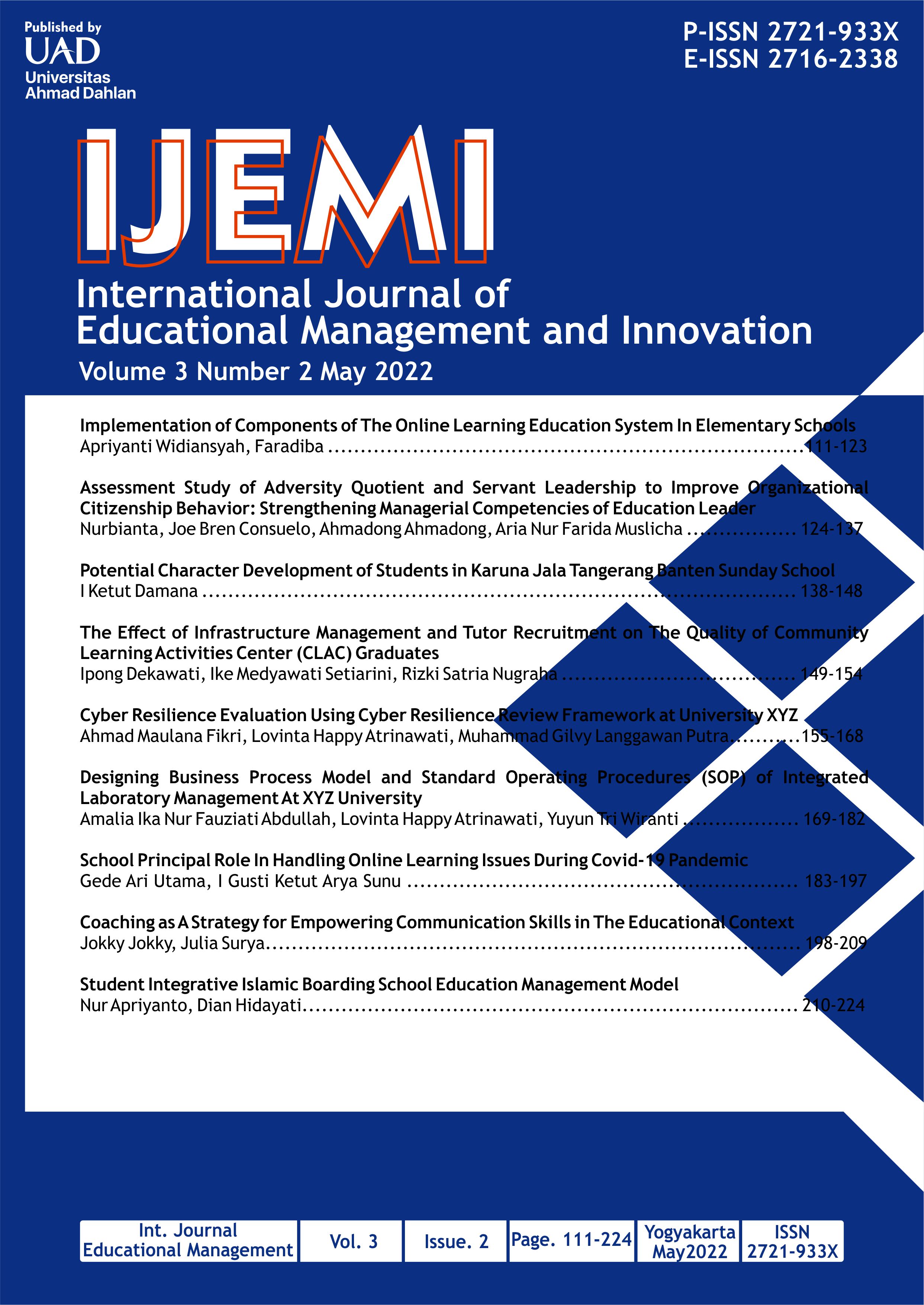The Effect of Infrastructure Management and Tutor Recruitment on The Quality of Community Learning Activities Center (CLAC) Graduates
DOI:
https://doi.org/10.12928/ijemi.v3i2.5793Keywords:
Graduates quality, Infratructure management, Tutor RecruitmentAbstract
This study aims to determine how much influence infrastructure management and tutor recruitment partially or jointly have on the quality of graduates in CLAC. The research was conducted using a descriptive correlational method with a quantitative approach. The analysis was carried out by distributing questionnaires to 50 respondents who were the samples in this study. The results of this study reveal that it can be concluded that: 1) There is a significant influence of infrastructure management on the quality of graduates in CLAC. 2) There is a significant effect of tutor recruitment on the quality of graduates in CLAC. 3) There is a significant influence of infrastructure management and tutor recruitment on the quality of graduates in CLAC. The magnitude of infrastructure management and tutor recruitment influences the quality of graduates in CLAC; this study strengthens and proves or is in line with several experts and researchers. Previous writers stated that the quality of graduates was heavily influenced by infrastructure management.
References
Acep Mulyadi. (2020). DAMPAK MANAJEMEN SARANA PRASARANA TERHADAP MUTU PENDIDIKAN. Jurnal Syntax Admiration, 1(8), 1004–1022.
Amat Jaedun, V. Lilik Hariyanto, dan N. E. R. (2017). PENGEMBANGAN MODEL PEMBELAJARAN PRODUKTIF BERMUATAN KEWIRAUSAHAAN. JURNAL KEPENDIDIKAN, 1(1), 125–138.
Bafadal, I. (2003). Peningkatan profesionalisme guru sekolah dasar dalam kerangka manajemen peningkatan mutu berbasis sekolah (1st ed.). Bumi Aksar.
Coning, A. De, & Mouton, F. (2020). Bulk infrastructure management for facilities management. 2020 Resilience Week, RWS 2020, November, 181–187. https://doi.org/10.1109/RWS50334.2020.9241262
Depdiknas. (2003). UNDANG-UNDANG REPUBLIK INDONESIA NOMOR 20 TAHUN 2003 TENTANG SISTEM PENDIDIKAN NASIONAL. In UNDANG-UNDANG REPUBLIK INDONESIA NOMOR 20 TAHUN 2003 TENTANG SISTEM PENDIDIKAN NASIONAL. https://doi.org/10.24967/ekombis.v2i1.48
Fadhli, M. (2017). Manajemen Peningkatan Mutu Pendidikan. Tadbir : Jurnal Studi Manajemen Pendidikan, 1(2), 218. https://doi.org/10.29240/jsmp.v1i2.295
Gasparini, G., Brunelli, M., & Chiriac, M. D. (2022). Multi-period portfolio decision analysis: A case study in the infrastructure management sector. Operations Research Perspectives,9, 100213. https://doi.org/10.1016/J.ORP.2021.100213
Gondia, A., Ezzeldin, M., & El-Dakhakhni, W. (2022). Dynamic networks for resilience-driven management of infrastructure projects. Automation in Construction, 136, 104149. https://doi.org/10.1016/J.AUTCON.2022.104149
Hulpia, H., & Valcke, M. (2004). The use of performance indicators in a school improvement policy: The theoretical and empirical context. Evaluation and Research in Education, 18(1–2), 102–119. https://doi.org/10.1080/09500790408668311
Kintamani DH, I. (2012). Kinerja Pendidikan Kesetaraan sebagai Salah Satu Jenis Pendidikan Nonformal. Jurnal Pendidikan Dan Kebudayaan, 18(1), 65. https://doi.org/10.24832/jpnk.v18i1.70
Kokkaew, N., Jokkaw, N., Peansupap, V., & Wipulanusat, W. (2022). Impacts of human resource management and knowledge management on non-financial organizational performance: Evidence of Thai infrastructure construction firms. Ain Shams Engineering Journal, 13(6), 101750. https://doi.org/10.1016/J.ASEJ.2022.101750
Matin, N. F. (2017). Manajemen Sarana dan Prasarana Pendidikan : Konsep dan Aplikasinya (2nd ed.). Rajawali Pers.
S.Adevia Ayu Kusumaning Putri; Karwanto. (2021). Sistem Rekrutmen Guru Dalam Upaya Meningkatkan Mutu Pendidikan. Inspirasi Manajemen Pendidikan, 09(01), 229–239.
Tien, Y. C. (2015). Manajemen Peningkatan Mutu Guru. Manajer Pendidikan, 9(4), 579–587. https://ejournal.unib.ac.id/index.php/manajerpendidikan/article/download/1159/967
Downloads
Published
How to Cite
Issue
Section
License
Copyright (c) 2022 Universitas Ahmad Dahlan

This work is licensed under a Creative Commons Attribution-ShareAlike 4.0 International License.
The copyright to this article is transferred to Universitas Ahmad Dahlan (UAD) if and when the article is accepted for publication. The undersigned hereby transfers any rights in and to the paper including without limitation all copyrights to UAD. The undersigned hereby represents and warrants that the paper is original and that he/she is the author of the paper, except for material that is identified as to its source, with permission notices from the copyright owners where required. The undersigned represents that he/she has the power and authority to make and execute this assignment.
We declare that:
This paper has not been published in the same form elsewhere.
It will not be submitted anywhere else for publication before acceptance/rejection by this Journal.
Copyright permission is obtained for materials published elsewhere and which require this permission for reproduction.
Furthermore, I/We hereby transfer the unlimited rights of publication of the above-mentioned paper in whole to UAD. The copyright transfer covers the exclusive right to reproduce and distribute the article, including reprints, translations, photographic reproductions, microform, electronic form (offline, online), or any other reproductions of similar nature.
The corresponding author signs for and accepts responsibility for releasing this material on behalf of any and all co-authors. This agreement is to be signed by at least one of the authors who have obtained the assent of the co-author(s) where applicable. After submission of this agreement signed by the corresponding author, changes of authorship or in the order of the authors listed will not be accepted.
Retained Rights/Terms and Conditions
Authors retain all proprietary rights in any process, procedure, or article of manufacture described in the Work.
Authors may reproduce or authorize others to reproduce the Work or derivative works for the authors' personal use or for company use, provided that the source and the UAD copyright notice are indicated, the copies are not used in any way that implies UAD endorsement of a product or service of any employer, and the copies themselves are not offered for sale.
Although authors are permitted to re-use all or portions of the Work in other works, this does not include granting third-party requests for reprinting, republishing, or other types of re-use.




